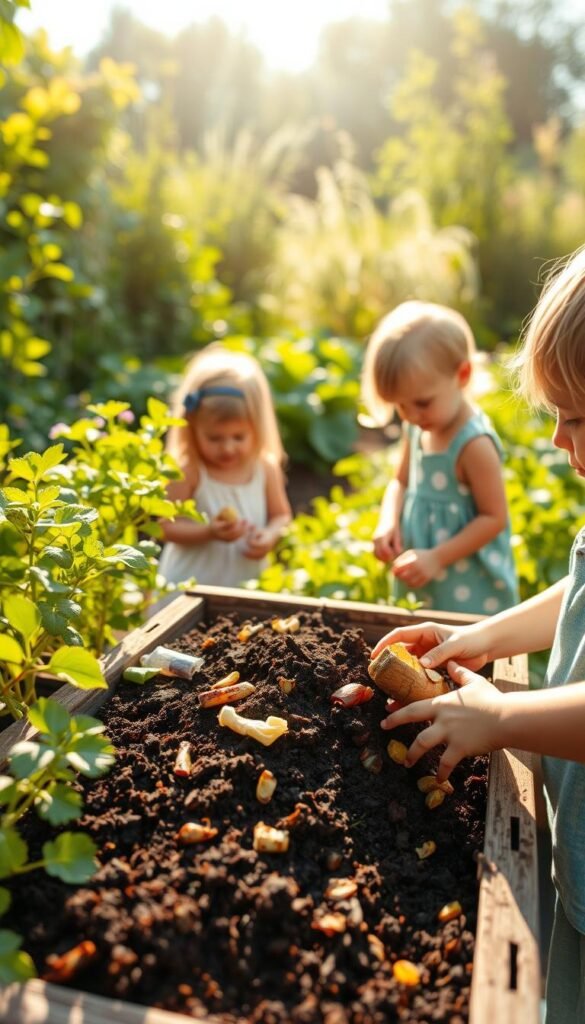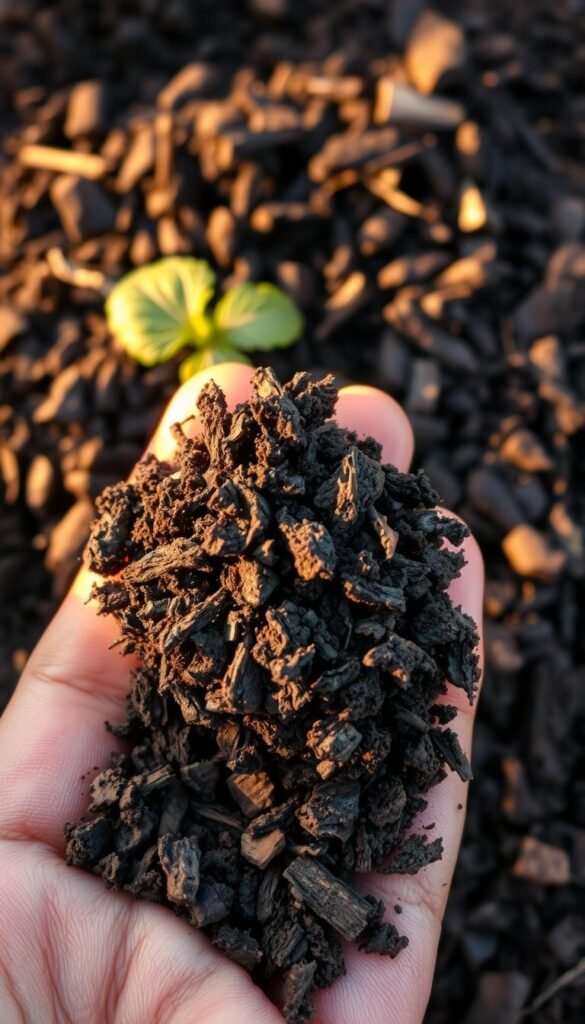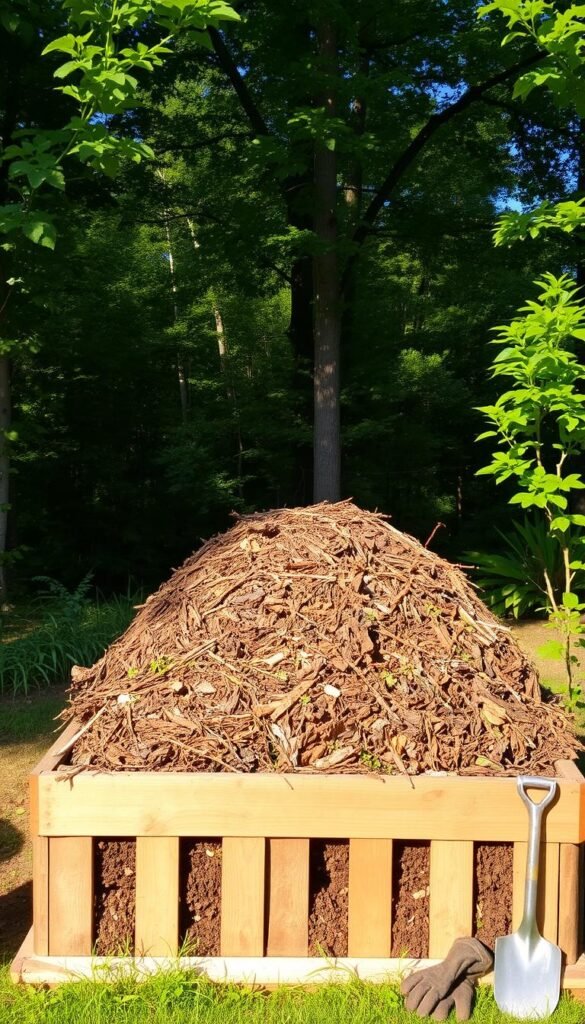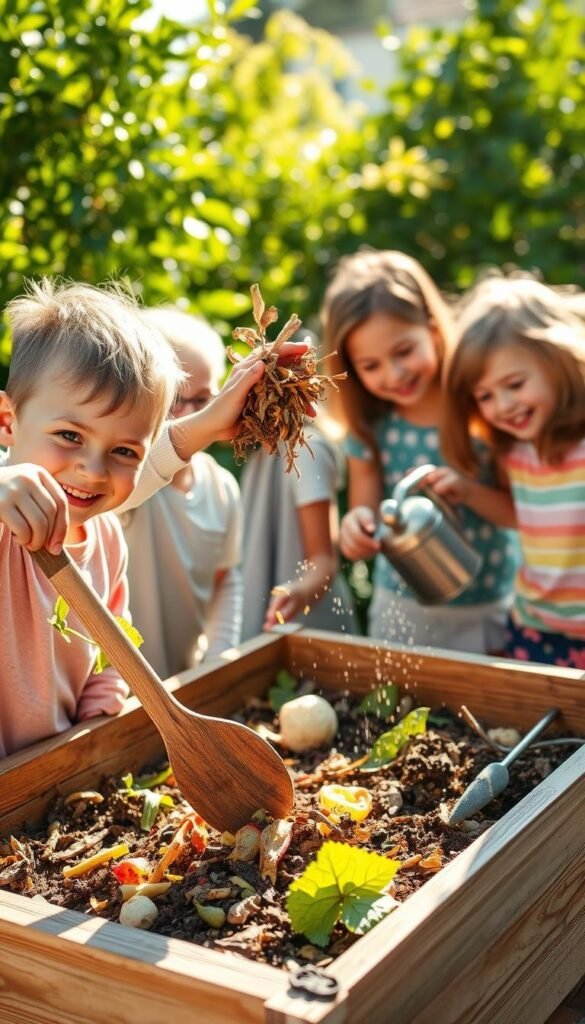Did you know banana peels and apple cores could become superheroes for your garden? Every day, food scraps get thrown away across America. In fact, nearly one-fourth of landfill space holds leftovers that could instead feed plants. But there’s a better way to handle these everyday items—and it’s as easy as starting a mini recycling station in your backyard.
Imagine showing young explorers how old carrot tops and eggshells transform into nutrient-rich soil food. This process isn’t just magical—it’s science in action! By mixing brown leaves with green leftovers, you create a living classroom where decay becomes growth. Kids discover how worms, microbes, and time work together to make “black gold” for gardens.
Best of all, this activity tackles real-world problems. When organic waste breaks down in landfills, it releases methane—a gas that heats our planet faster. Redirecting scraps to compost bins cuts these emissions while teaching responsibility. Plus, families save money on fertilizers and reduce trash bags heading to the curb.
Ready to spark curiosity and environmental pride? This hands-on project turns ordinary moments into lifelong lessons about nature’s cycles. Together, you’ll grow more than plants—you’ll nurture tomorrow’s eco-conscious leaders.
Introduction to Composting and Its Benefits for Kids

Transforming trash into treasure isn’t just a fairy tale—it’s science! When you mix banana peels with fallen leaves, you create a living laboratory where food waste becomes plant superfood. This process teaches young minds how nature renews itself through decomposition, turning what we don’t eat into what plants crave.
Growing Green Minds
Kids learn best through hands-on adventures. Sorting materials into “greens” and “browns” becomes a detective game. They’ll cheer when spotting the first wiggly worm helping break down orange rinds. These experiences build eco-awareness that lasts longer than any textbook lesson.
Earth’s Hidden Superpower
Landfills release 20 times more methane than properly managed compost systems. By redirecting apple cores to backyard bins, you prevent harmful gases while creating soil that stores carbon. It’s like giving the planet a vitamin boost!
| Landfill Outcome | Compost Outcome | Kid-Friendly Benefit |
|---|---|---|
| Creates methane gas | Makes nutrient-rich soil | Teaches gas cycle science |
| Wastes space | Saves trash costs | Shows money-saving skills |
| Pollutes groundwater | Improves plant growth | Offers gardening rewards |
Families using this method often cut their trash by 30%. That’s 300 fewer pounds yearly for an average household! More importantly, children discover their actions directly impact ecosystems—a lesson no screen time can match.
Understanding What Compost Is

What if I told you there’s a secret recipe that turns leftovers into plant superfood? That’s exactly what happens when organic matter transforms through decomposition. Gardeners call this dark, crumbly substance “black gold” – not because it sparkles, but because it makes soil burst with life!
Imagine billions of invisible chefs working day and night. Microscopic bacteria and fungi break down banana peels and grass clippings, creating a feast for plants. This process turns apple cores into something resembling chocolate cake crumbs – but with an earthy forest aroma that says “healthy soil“.
The magic happens through teamwork. Materials like fallen leaves (browns) and coffee grounds (greens) combine like ingredients in nature’s kitchen. As they decompose, they release nutrients plants need to grow strong – nitrogen for leafy greens, phosphorus for roots, and potassium for flowers.
Finished compost acts like a superhero cape for dirt. It helps soil hold water during dry spells while letting extra rain drain away. Plus, it’s packed with tiny creatures that keep earth healthy. One handful contains more living things than all the people on Earth!
Creating this organic matter isn’t just science – it’s nature’s recycling program. When you mix the right materials and let time work its magic, you’re cooking up the perfect meal for every plant in your neighborhood.
How to Start a Compost Pile with Kitchen Scraps

Building a compost pile is like creating a mini ecosystem right outside your door. With just a few simple steps, you’ll watch yesterday’s apple cores become tomorrow’s plant food. Let’s break down the process into kid-friendly actions that yield real results.
Selecting the Ideal Spot in Your Backyard
Find a backyard area that gets morning sun and afternoon shade. This keeps your pile from drying out or getting too soggy. Show kids how to test drainage by pouring water on the ground—if it disappears quickly, you’ve found a winner!
Elevated spots work best. Avoid placing your compost pile near fences or trees where roots might invade. A flat section of yard with easy access to water makes maintenance simple. Pro tip: mark the area with colorful flags for added excitement!
Layering Green and Brown Materials
Start with a brown materials base—crunchy leaves or shredded paper work perfectly. Explain how these carbon-rich layers act like a sponge for moisture. Then add green materials—think veggie peels or fresh grass clippings—that pump nitrogen into the mix.
Follow this simple pattern:
- Brown layer (2 parts)
- Green layer (1 part)
- Soil sprinkle (optional)
Keep alternating until yourpilereaches 3 feet tall. This “lasagna method” helps microbes break downmaterialsfaster.
Check moisture weekly by squeezing a handful. Aim for dampness like a wrung-out sponge. Too dry? Add water or green materials. Too wet? Mix in extra brown materials. Within weeks, you’ll see steam rising—nature’s way of saying “Good job!”
Safe and Kid-Friendly Composting Materials

Your kitchen holds hidden treasures that can power up plants—if you know where to look! Turn snack time into a scavenger hunt by identifying materials that belong in nature’s recycling bin. Stale bread crusts, watermelon rinds, and squishy berries all qualify as scraps worthy of transformation.
Morning routines become eco-lessons when you add used coffee grounds or tea bags to the mix. Show kids how to remove staples from tea tags—it’s like defusing a tiny bomb before the good stuff goes in! Crushing eggshells becomes a satisfying crunch-fest while explaining how calcium strengthens plant stems.
Not all materials play nice. Create a “no-go zone” list with sticky notes: greasy pizza boxes, yogurt cups, and dog poop stay out. Compare it to keeping rotten apples away from fresh ones—everything stays healthier that way!
| Superhero Materials | Villain Materials | Why It Matters |
|---|---|---|
| Apple cores | Cheese slices | Prevents mold |
| Carrot tops | Chicken bones | Stops pests |
| Crushed walnuts | Butter wrappers | Keeps soil clean |
Turn your countertop into a sorting station. Let young helpers separate fruit and vegetable peels from real trash. Celebrate finds like avocado skins or pineapple crowns—they’re VIP guests in the compost club!
When kids spot a banana peel destined for the bin, shout “Stop! That’s plant food!” Watch their eyes light up realizing yesterday’s snack becomes tomorrow’s garden booster. Now that’s what we call a power move for the planet!
Exploring Different Composting Methods
Nature offers multiple recipes for recycling leftovers—each with its own flavor! Just like choosing between baking cookies or stir-frying veggies, families can pick the method that fits their space and lifestyle. Let’s explore four exciting techniques that turn scraps into soil magic.
Traditional Compost Pile and Bin Techniques
The classic compost pile works like a campfire—layer browns and greens in open air, then stir occasionally. Perfect for yards with fallen leaves and grass clippings! For quicker results, try a compost bin. These containers trap heat and moisture, speeding up decomposition. They’re ideal for patios or urban homes wanting tidier setups.
Bokashi and Vermicomposting Options
Meet nature’s cleanup crew: red wiggler worms! In vermicomposting, these squiggly helpers munch through scraps in ventilated bins, creating nutrient-packed castings. Prefer indoor solutions? Bokashi uses special microbes to ferment waste in sealed buckets—no odor, just tangy-smelling “pickled” scraps ready to bury.
| Method | Best For | Kid Appeal |
|---|---|---|
| Open Pile | Spacious yards | Mixing ingredients like chefs |
| Bin System | Balconies | Watching steam rise |
| Worm Farm | Classrooms | Pet-like caretaking |
| Bokashi | Apartments | Shaking buckets daily |
One family in Oregon reduced their trash by half using worms, while a Chicago teacher reported her students’ excitement over bokashi bubbles. Whether you’re digging trenches or feeding wriggly friends, every method teaches valuable lessons about nature’s circular economy.
Composting for Children: Turn Kitchen Scraps into Garden Gold

What if your leftovers could fight climate change? Every time young stewards toss orange peels into a compost bin instead of trash, they’re joining Earth’s cleanup crew. Nearly 30% of household waste becomes garden-boosting treasure through this simple way of recycling.
Families using kitchen scraps for compost prevent 300 pounds of methane emissions yearly—equal to a car driving 1,000 miles! Kids become environmental heroes by:
- Diverting banana skins from landfills
- Watching microbes transform waste
- Growing healthier tomato plants
That crumbly dark soil isn’t just dirt—it’s packed with nutrients that make flowers bloom brighter. One tablespoon contains more living organisms than Earth’s human population!
“When children see their apple cores become plant food, they grasp their power to heal ecosystems.”
Start small. A countertop container for coffee grounds and carrot tops makes daily eco-actions visible. Celebrate when the bin fills up—each scoop represents cleaner air and richer earth. Remember: even a single avocado pit kept from landfills helps future forests breathe easier.
This journey turns science into magic. Young minds discover how nature repurposes everything, proving that every scrap matters. Ready to let your family’s waste become the world’s wonder?
Maintaining Your Compost Pile: Essential Tips
Think of your compost pile as a living creature—it breathes, drinks, and eats just like you! The secret to success lies in balancing three elements: moisture, air, and time. Get this trio working together, and you’ll create nature’s perfect recycling machine.
Hydration Station
Your pile loves rainy-day consistency. Grab a handful—if water drips out, add dry leaves. If it crumbles, sprinkle water like you’re feeding a thirsty friend. Cover with cardboard during heavy storms to prevent sogginess. Kids enjoy testing textures, comparing dampness to wrung-out sponges or slightly wet sandcastles.
Oxygen Dance Party
Microbes need to breathe! Use a stick to poke holes in the compost pile, creating air tunnels. Turn layers every 10 days using a shovel—imagine flipping pancakes so both sides cook evenly. Watch steam rise on chilly mornings as invisible workers heat up their underground kitchen.
Set weekly check-ins where young helpers:
- Measure temperature with their hands
- Spot new decomposers like pill bugs
- Chart progress in a nature journal
With patience and playful care, that pile transforms into dark, crumbly earth—proof that small hands can create big changes. Every turned layer fights climate change while growing greener thumbs!






